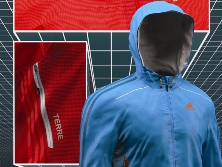Virtualisation has been a strategic initiative for the adidas Group since back in 2004, after we proactively began to look into how the automotive and aerospace industries were successfully showing their products using digital 3D technology.

Therefore, at the start of our journey we asked ourselves how to create photorealistic images of footwear and apparel in 3D that could one day be an integral part of the adidas Group’s product and sales engine. How to create virtual product that is accurate enough for decision-making?
The challenge
Initially, it was not an easy process, as there are two major differences to the automotive industry: first, sporting goods are not made of hard surfaces but are soft, draping and have complex textures. Secondly, we are not just working on a handful of styles, but we produce thousands of different articles per year! This means that, in order to provide the virtual products, 3D models need to be created for every model and colour way on time and in the right quality. Quite a challenge!
Excellent implementation
Today, we are really proud to say that, since the kick-off, we have made great progress. We have a smooth process established and all our core factories are trained and now capable of producing high-quality volumes of virtual samples. In addition, virtualisation is a company-wide and cross-functional initiative that involves colleagues from departments like Marketing, Sales, Sourcing and Global IT, as well as our core suppliers. For the moment, the main focus of the project has been on the “virtual sell-in” process, and that is the phase in which we sell product to our retailers.
The immediate benefit of virtualisation is that it allows us to increasingly reduce the quantity of physical samples required to design and sell new products. Compared to 2010, when the initiative was given the full green light, we have been able to save more than 1 million physical samples. With virtualisation, we save resources and money by reducing material waste, transportation and distribution costs. And with fewer samples being flown around the globe, we are also reducing our carbon emissions!
As well as being environmentally friendly, virtualisation is also innovative, quick and efficient as images are very realistic and easy to change in real time, which allows faster decision-making.
Expanding virtualisation to other areas of the business
While the focus so far has been on the “sell-in” process, we are currently looking into going virtual in design, meaning that our designers will be able to design in 3D at the very beginning of the creation process. We are also bringing virtualisation to customers in our retail environment globally, using state-of-the-art touch-screen Virtual Walls where shoppers can select products on a virtual shelf.
What makes us extremely proud of this project is that we are industry-leading in further developing the 3D technology; plus, we have established an innovative way of working with our suppliers, product creators and sales department to utilise virtualisation to its full extent – in a sustainable way





